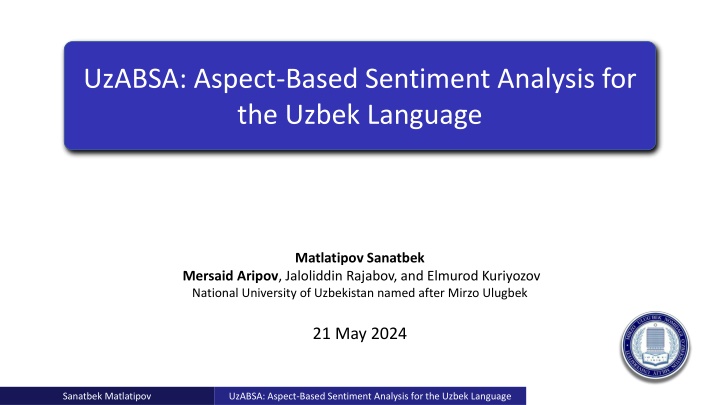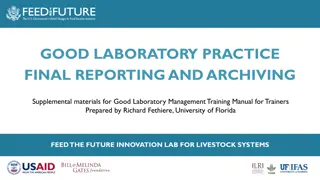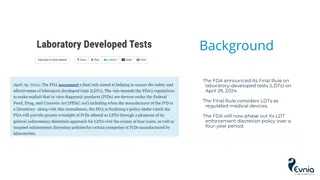
Aspect-Based Sentiment Analysis for Uzbek Language Research
Explore the significance of Aspect-Based Sentiment Analysis (ABSA) in understanding sentiments expressed in the Uzbek language. Learn about the lack of sentiment analysis resources for underrepresented languages like Uzbek, and the importance of developing ABSA resources for inclusivity in natural language processing research.
Download Presentation

Please find below an Image/Link to download the presentation.
The content on the website is provided AS IS for your information and personal use only. It may not be sold, licensed, or shared on other websites without obtaining consent from the author. If you encounter any issues during the download, it is possible that the publisher has removed the file from their server.
You are allowed to download the files provided on this website for personal or commercial use, subject to the condition that they are used lawfully. All files are the property of their respective owners.
The content on the website is provided AS IS for your information and personal use only. It may not be sold, licensed, or shared on other websites without obtaining consent from the author.
E N D
Presentation Transcript
UzABSA: Aspect-Based Sentiment Analysis for the Uzbek Language Matlatipov Sanatbek Mersaid Aripov, Jaloliddin Rajabov, and Elmurod Kuriyozov National University of Uzbekistan named after Mirzo Ulugbek 21 May 2024 Sanatbek Matlatipov UzABSA: Aspect-Based Sentiment Analysis for the Uzbek Language
Contents Introduction Machine learning Review(Uzbek NLP) Purpose Shared Tasks & Annotation Evaluations & Conclusion Sanatbek Matlatipov UzABSA: Aspect-Based Sentiment Analysis for the Uzbek Language
Introduction Uzbek Language(I-III) Review(Uzbek NLP) Purpose Shared tasks & Annotation Evaluation & Conclusion INTRODUCTION Aspect-Based Sentiment Analysis (ABSA) fine-grained approach to sentiment analysis that goes beyond determining the overall sentiment of a text. It identifies and extracts specific aspects or features mentioned in a text and determines the sentiment expressed towards each aspect. Sentiment analysis is a crucial tool for understanding public opinion and making data-driven decisions in various fields such as marketing, customer service, and social media monitoring. Despite its importance, there is a lack of sentiment analysis resources for many underrepresented languages, including Uzbek. Developing ABSA resources for Uzbek not only helps in better understanding sentiments expressed in this language but also promotes inclusivity in natural language processing (NLP) research, ensuring that the benefits of these technologies are accessible to speakers of all languages. Sanatbek Matlatipov UzABSA: Aspect-Based Sentiment Analysis for the Uzbek Language
Introduction Uzbek Language(I-III) Review(Uzbek NLP) Purpose Shared tasks & Annotation Evaluation & Conclusion Uzbek Language I Not enough work done Low-Resource(NLP resources) low density Our Language is Uzbek Official language of Uzbekistan Native to All CA Countries, Afghanistan, Russia, Xinjiang(China) Spoken by 37 million (as of 2024) Sanatbek Matlatipov UzABSA: Aspect-Based Sentiment Analysis for the Uzbek Language
Introduction Uzbek Language(I-III) Review(Uzbek NLP) Purpose Shared tasks & Annotation Evaluation & Conclusion Uzbek Language II It is an eclectic mixture of Turkic, Persian, and Arabic Uzbek (along with Uyghur) can be considered the direct descendant of Chagatai, the language of great Turkic Central Asian literary development in the realm of Chagatai Khan, Timur (Tamerlane), and the Timurid dynasty (including the early Mughal rulers of the Mughal Empire). Unlike other Turkic languages, vowel harmony is almost completely lost in modern Standard Uzbek, though it is still observed to some degree in its dialects, as well as in Uyghur. https://en.wikipedia.org/wiki/Uzbek_language * The picture is taken from here Sanatbek Matlatipov UzABSA: Aspect-Based Sentiment Analysis for the Uzbek Language
Introduction Uzbek Language(I-III) Review(Uzbek NLP) Purpose Shared tasks & Annotation Evaluation & Conclusion Uzbek Language III Turkic Family Null Subject No Articles No Gender Subject-object-verb Sanatbek Matlatipov UzABSA: Aspect-Based Sentiment Analysis for the Uzbek Language
Introduction Uzbek Language(I-III) Review(Uzbek NLP) Purpose Shared tasks & Annotation Evaluation & Conclusion Uzbek NLP progress * M.Musaevlar * Dictionaries, synsets, and stopwords. The book of Uzbek dictionary words in both Latin and Cyrillic scripts [Tog ayev et al.(1999)], WordNet type synsets data [Agostini et al.(2021)], and WordNet type thesaurus datasets [Aripov(2018)]. Automatic detection of stopwords in Uzbek has been proposed by Madatov et. al. [Madatov et al.(2022)]. * Language identification, and Tokenization - (both sentence-level and word-level) are general tasks that, once done, can easily include the majority of languages at once. Moreover, [Bakaev, Ilkhom. (2021). Tokenization task] * Written scripts and machine transliteration - [Mansurov and Mansurov(2021a)] propose a tool based on decision tree to transliterate between Cyrillic and Latin scripts. Recent work from [Salaev et al.(2022a), Kuriyozov, and G omez-Rodr guez] worked on machine transliteration. * Morphological Analysis(MA). The first works on Uzbek morphological analyzers was done using the rule-based method[Matlatipov and Vetulani(2009)]. The Apertium-Uzb monolingual package also has the biggest available annotated wordlist for Uzbek. [Nilufar Abdurakhmonova & Tuliyev have paper on FST based MA.] * Text Classification. [Ignatev N.A., Tuliyev U.] worked on creating patterns from NLWords based on text(document). * Machine Translation: [Aripov, Khakimov M., Matlatipov S.,, Abdurakhmonova N., Allaberdiyev B., Altynbek Sharipbay] * Sentiment Analysis: [Aripov Mersaod, Matlatipov Sanatbek, Kuriyozov Elmurod, Rabbimov Ilyos, Kobilov Sami] NO ABSA resource for Uzbek language Overall contributers: Sh.Nazirov, . Po latov, O .Xamdamov, S.Qobilov(SamDU) va Sanatbek Matlatipov UzABSA: Aspect-Based Sentiment Analysis for the Uzbek Language
Introduction Uzbek Language(I-III) Review(Uzbek NLP) Purpose Shared tasks & Annotation Evaluation & Conclusion Purpose The first annotated dataset for aspect-based sentiment analysis in the Uzbek language comprises reviews sourced from the domain of Uzbek restaurants which was pre-processed as well as cleaned from our previous work(Matlatipov et al., 2022). Annotation guideline has been developed for annotators Evaluated the dataset using inter-annotator agreement using Cohen s Kappa, Krippendorff s as well as classification model, namely K-Nearest Neighbour (KNN). * The work inspired by this work [SemEval-2014 Task 4: Aspect Based Sentiment Analysis](https://aclanthology.org/S14- 2004) (Pontiki et al., SemEval 2014) Sanatbek Matlatipov UzABSA: Aspect-Based Sentiment Analysis for the Uzbek Language
Introduction Uzbek Language(I-III) Review(Uzbek NLP) Purpose Shared tasks & Annotation Evaluation & Conclusion Shared Tasks Task1(T1) Aspect term extraction: Given a set of sentences with pre-identified entities (e.g., restaurants), identify the aspect terms present in the sentence and return a list containing all the distinct aspect terms. An aspect term names a particular aspect of the target entity. Xizmat va xodimlar muomilasimenga yoqdi, ammo ovqat yamon ekan ("I liked the service and the staff, but the food"). Task2(T2) Aspect term polarity: For a given set of aspect terms within a sentence, determine whether the polarity of each aspect term is positive, negative, neutral or conflict (i.e., both positive and negative). same example above: Xizmat va xodimlar muomilasimenga yoqdi, ammo ovqat yamon ekan === {xizmat: positive, xodimlar: positive, ovqat: negative Task3(T3) Aspect Category detection: Given a predefined set of aspect categories (ovqat(food), xizmat(service), narxi(price), muhit(environment, atmosphere), and boshqa(misc.)), identify the aspect categories discussed in a given sentence. Aspect categories are typically coarser than the aspect terms of task 1, and they do not necessarily occur as terms in the given sentence. Task4:Aspect category polarity: Given a set of pre-identified aspect categories (e.g., {food, price}), determine the polarity (positive, negative, neutral or conflict) of each aspect category. Sanatbek Matlatipov UzABSA: Aspect-Based Sentiment Analysis for the Uzbek Language
Introduction Uzbek Language(I-III) Review(Uzbek NLP) Purpose Shared tasks & Annotation Evaluation & Conclusion Annotation We are given the corpus of reviews where our tasks are extracting Aspect Terms, Aspect Terms Polarities, Aspect Category Terms and Aspect Categories Polarities. Sanatbek Matlatipov UzABSA: Aspect-Based Sentiment Analysis for the Uzbek Language
Introduction Uzbek Language(I-III) Review(Uzbek NLP) Purpose Shared tasks & Annotation Evaluation & Conclusion Annotation Two annotator is participated in the process where one of them is expert in linguistics. Annotation guideline link(7 pages): https://docs.google.com/document/d/1juYoOn1h- zAvs4facFhzFw5KKkOfsM78/edit?usp=sharing&ouid=108484967563589516106&rtpof=true&sd=true The last step is the conversion of annotation format-based datasets into other suitable formats, such as JSONL, XML, and Parquet, therefore making them accessible on the HuggingFace platform. The annotation of each aspect term, together with its corresponding sentiment, is performed for every review sentence. Aspect categories are annotated using predefined five restaurant-related domain terms, and their polarities, namely positive, negative, neutral, and conflict. Sanatbek Matlatipov UzABSA: Aspect-Based Sentiment Analysis for the Uzbek Language
Introduction Uzbek Language(I-III) Review(Uzbek NLP) Purpose Shared tasks & Annotation Evaluation & Conclusion Evaluation Above, the A confusion matrix (Figure 2) is illustrated for T2, T3 and T4 tasks, whereas, the T1 task has more than 650 classes, so we decided to skip the illustration. Sanatbek Matlatipov UzABSA: Aspect-Based Sentiment Analysis for the Uzbek Language
Introduction Uzbek Language(I-III) Review(Uzbek NLP) Purpose Shared tasks & Annotation Evaluation & Conclusion Evaluation Sanatbek Matlatipov UzABSA: Aspect-Based Sentiment Analysis for the Uzbek Language
Introduction Uzbek Language(I-III) Review(Uzbek NLP) Purpose Shared tasks & Annotation Evaluation & Conclusion Evaluation method(K-NN Implementation Steps) Step 1: Data Preparation Pre-processed, tokenized, stemmed(using our original idea) text data and applied stopwords. Prepared feature vectors, e.g., TF-IDF word embeddings, for each data point. Step 2: Choosing K Selected an appropriate value for the number of neighbours, K. chose K=5 as a starting point for demonstration purposes. K=5 means that for each data point, the model considered the five nearest neighbours for classification which helped the model s performance and be determined through experimentation. used techniques cross-validation to find the optimal K for the dataset. Step 3: Training Fit the K-NN model on the training data.. Sanatbek Matlatipov UzABSA: Aspect-Based Sentiment Analysis for the Uzbek Language
Introduction Uzbek Language(I-III) Review(Uzbek NLP) Purpose Shared tasks & Annotation Evaluation & Conclusion Conclusion In the work, we developed a corpora for Aspect-Based Sentiment Analysis (ABSA) specifically for the Uzbek language. We included four shared tasks and ensured reliable annotations by utilizing two annotators. (QR-code ) Evaluated the dataset using inter-annotator agreement using Cohen s Kappa, Krippendorff s as well as classification model, namely K-Nearest Neighbour (KNN). Sanatbek Matlatipov UzABSA: Aspect-Based Sentiment Analysis for the Uzbek Language
Introduction Uzbek Language(I-III) Review(Uzbek NLP) Purpose Shared tasks & Annotation Evaluation & Conclusion Future work Expanding the dataset to include more diverse sources and larger volumes of text(this part is almost ready ). Exploring more advanced machine learning models, such as neural networks, to improve accuracy. Conducting further error analysis to understand and mitigate common misclassifications. Extending this approach to other underrepresented languages, fostering inclusivity in NLP research. Sanatbek Matlatipov UzABSA: Aspect-Based Sentiment Analysis for the Uzbek Language
Introduction Uzbek Language(I-III) Review(Uzbek NLP) Purpose Shared tasks & Annotation Evaluation & Conclusion Acknowledgment This publication has been produced within the framework of the Grant REP- 25112021/113 - UzUDT: Universal Dependencies Treebank and parser for natural language processing on the Uzbek Language , funded under the MUNIS Project, supported by the World Bank and the Government of the Republic of Uzbekistan. The statements do not necessarily reflect the official position of the World Bank and the Government of the Republic of Uzbekistan. Exploring more advanced machine learning models, such as neural networks, to improve accuracy. Sanatbek Matlatipov UzABSA: Aspect-Based Sentiment Analysis for the Uzbek Language
THANK YOU VERY MUCH FOR YOUR ATTENTION E tiboringiz uchun RAHMAT! 18


![READ⚡[PDF]✔ Yup I'm Dead...Now What? The Deluxe Edition: A Guide to My Life Info](/thumb/20463/read-pdf-yup-i-m-dead-now-what-the-deluxe-edition-a-guide-to-my-life-info.jpg)

















